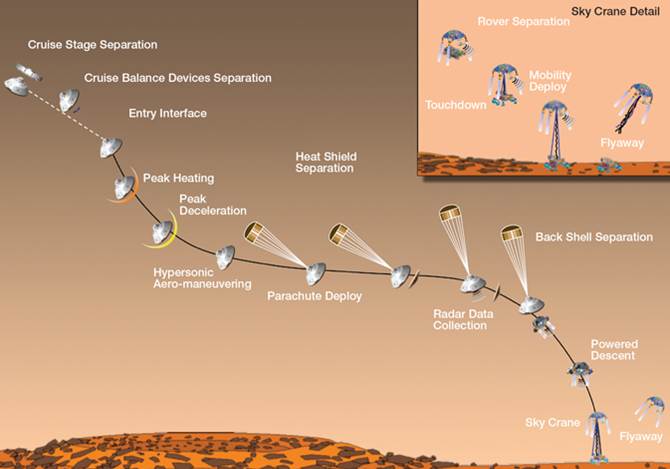Landing Phase
High Altitude
The orbital descent will take place over several days as the probe builds the momentum necessary
to slowly decrease orbital altitude. Aerobraking will be employed as much as possible as the Venusian
atmosphere thickens.
Medium Altitude
At approximately 250km of altitude, the upper part of the atmosphere, a drag parachute will deploy. The probe will slow to below supersonic
speeds. At approximately 65km of altitude, the parachute will release and the probe will commence free fall to the surface.
Ground Approach
The Venusian atmosphere quickly thickens from 65km to the surface. The expected descent rate in the lower atmosphere
is 10m/s. The probe is structurally hardened such that approaches near this velocity will ensure survival.
The graphic below illustrates the key points of entry into the Venus atmosphere. Unlike the Curiosity Mars rover pictured
here, following parachute separation, our lander will coast through the very dense atmosphere for the final 65km
and touch down without the need for an elaborate landing system. Touch down is on 07SEP2018, 50 days before
inferior conjuction. There will then be 5 days to complete drilling for proper seismograph placement and
charging the batteries at ambient temperature. Following that, line-of-sight communications will
be available with Earth and the primary science mission will begin.

Image courtesy of NASA http://www.nasa.gov/images/content/667372main_MSL%20EDL%20rev-2900.jpg
Communication Impact of Landing Site
Based on the orbital speeds of Earth and Venus, selecting a site on the equator will give an
elevation angle for line-of-sight communications that
should never be more than a maximum of 67 degrees below zenith. This corresponds to 180km of Venusian atmosphere
that signals will have to pass through to successfully communicate.